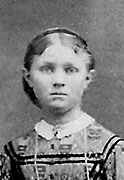Mendon May Day 1863

Seny Sorensen Queen of May
Ingeborg Kirstine Larsine Sorensen—
Seny, the name she is know to us best by, is generally credited with being the first Queen of the May in Mendon. She was only five years old when she arrived in Mendon with her parents from Mill Creek, Salt Lake County, Utah on the 10th of November, 1859. She is the first and only queen as far as is known, to be selected spontaneously by a group of her peers outside of the general guidance and influence of the adult members of the community. She was the second youngest queen, at the age of nine years, one month, and twenty-nine days old. The general consensus, of Seny being the first queen, is held by May Day traditionalists based both on oral family and community traditions and also the following written paragraphs, the first of which became somewhat of a Holy Grail
for Mendon May Day enthusiasts and local historians to locate and document.
Pioneer Entertainment
Then there was May Day. On the first day of May, Mary Willie, Seny Sorensen and a crowd of girls walked out to Clayton to gather flowers. They voted Seny Sorensen to be queen and had a wonderful time. They have always celebrated that day as May Day ever since.
The Mendon Fort
The farming land reached to the south as far as the Mill Pond or what we now call Clayton. It reached north as far as Richards Spring, and east as far as the (Little Bear) River.
Notes…
1863's Queen of the May, Seny Sorensen was crowned with woven flowers, by one of her girl friends. Clayton is the name given to Henry Hughes farm, located south and east of Mendon some three miles distant. All proper English farms of the day, have or had names and so Bishop Hughes gave his farm the proper name of Clayton. This is very near the old Mendon Mill site, from which little Rosie Thatcher was stolen by the Indians on April 7th, 1868. Also, Rebecca Basset Hughes, who was Henry’s fourth and last wife, lived out there on the farm for many years.
The name of Clayton was very problematic for me, no one living seemed to know the term. By the time I was looking to solve the location or place, everyone who might know the answer, had either died or moved away from Mendon. I found the answer in reading some of Henry Hughes personal papers, where he referred to the farm south of Mendon by that name.
I am sure the south fields would have been a lovely sight in the early spring of 1863, with wild flowers aplenty. It should also be noted that the beginnings of May Day in Mendon are entwined with the events of the Battle of Bear River. The pioneers of early Mendon would never let the children wander unprotected, if there was any threat of the Indians. So it is in this event that the people felt free enough to enjoy a few moments of celebration, constant guard not being needed at this time.
In 1865 and 1866 the threat of Indians would once again put the settlers on constant guard, but there was this brief window of time that the people of Mendon, for the first time since 1859, felt safe. They made the most of it with May Day, which we still enjoy today.